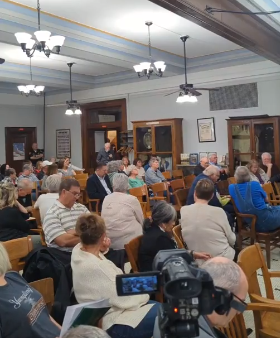Download Our Mobile App And Take WKTN With You . > > > > > > > > > > IT'S FREE!!

Hardin County – This July has been one of the wettest on record in some areas of the state, and with the extra moisture, comes concerns about diseases. Gray Leaf Spot (GLS) and, to a lesser extent, northern corn leaf blight (NCLB), have already been reported in some fields, well before tasseling in some cases.
Such early disease development could impact grain yield, especially if it continues to be wet and the hybrid is susceptible. GLS is favored by warm temperatures (70 and 90 F) and high relative humidity. NCLB is also favored by wet, but slightly cooler (64 and 80 F) conditions, than GLS. Over the last several days, we have had temperatures within the favorable range for both diseases, and if they continue to spread and damage the ear leaf before grain fill is complete, yield losses could be high.
GLS and NCLB are not the only diseases on the minds of growers this year. Questions are also being asked about tar spot, a relatively new foliar disease that is also driven by wet conditions. Although grain prices may be high enough to justify a fungicide application, it is still important to scout fields to see what is out there and at what levels before making a decision, as this could affect your fungicide choice, your application program, and the price you pay, and as a result, whether or not you see a return on your investment. For instance, GLS and NCLB can be effectively controlled with several of the older, cheaper, and single-mode-of-action fungicides. If these are the diseases of concern, you should not have to spend the extra money to apply one of the newer, more expensive fungicides.
However, if tar spot is what you are most concerned about, you may want to consider a combination fungicide with multiple modes of action, as these tend to be more consistently effective against tar spot. Several of the newer premix fungicides that provide good control of tar spot are also more expensive, but the good news is, they are also effective against GLS and NCLB. Therefore, it you decide to spend the extra money, make sure it is justified by scouting the field to see what is present. However, regardless of which fungicide you choose, it would be a good idea to use a surfactant, unless it is restricted by the label, if the application is made while or shortly before it rains. A surfactant may help to increase the rain-fastness of the fungicide.
Based on years of research, we have found that applications made at silking (R1) or tasseling (VT) are the most effective in terms of foliar disease control and yield response in Ohio. But the yield response is much lower and more variable when fungicides are used under low disease pressure or in the absence of foliar diseases, than when a disease is present. If the fungicide program costs $30 an acre and the grain price is $5, you will need at least a 6 bushel increase in yield to offset your application cost. You stand a better chance of seeing such a yield response if disease pressure is high (weather is favorable and hybrid is susceptible). On average, the yield response tends to be about 3 bushels and highly variable in the absence of disease, and as such will only be economically beneficial if a cheaper fungicide is used.
Other information that is available to help you make your fungicide application decision include a hybrid’s susceptibility to a given disease. Susceptible hybrids: If disease symptoms are present on the third leaf below the ear or higher on 50% of the plants examined, a fungicide is recommended. Intermediate hybrids: If disease symptoms are present on the third leaf below the ear or higher on 50% of the plants examined, AND the field is in an area with a history of foliar disease problems, the previous crop was corn, and there is 35% or more surface residue, and the weather is warm and humid through July and August, a fungicide is recommended. Resistant hybrids: Fungicide applications generally are not recommended.
Article written by Pierce Paul, OSU Extension-Ag Crops Team and edited by Mark Badertscher, OSU Extension-Hardin County.
Written by: WKTN Staff
Similar posts
Copyright WKTN-Home Town Media | Public File | FCC Applications | ADMIN | 112 N. Detroit Street, Kenton, OH 43326 | 419-675-2355


